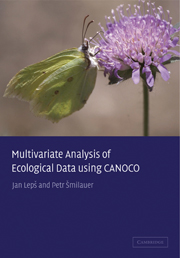Book contents
- Frontmatter
- Contents
- Preface
- 1 Introduction and data manipulation
- 2 Experimental design
- 3 Basics of gradient analysis
- 4 Using the Canoco for Windows 4.5 package
- 5 Constrained ordination and permutation tests
- 6 Similarity measures
- 7 Classification methods
- 8 Regression methods
- 9 Advanced use of ordination
- 10 Visualizing multivariate data
- 11 Case study 1: Variation in forest bird assemblages
- 12 Case study 2: Search for community composition patterns and their environmental correlates: vegetation of spring meadows
- 13 Case study 3: Separating the effects of explanatory variables
- 14 Case study 4: Evaluation of experiments in randomized complete blocks
- 15 Case study 5: Analysis of repeated observations of species composition from a factorial experiment
- 16 Case study 6: Hierarchical analysis of crayfish community variation
- 17 Case study 7: Differentiating two species and their hybrids with discriminant analysis
- Appendix A Sample datasets and projects
- Appendix B Vocabulary
- Appendix C Overview of available software
- References
- Index
14 - Case study 4: Evaluation of experiments in randomized complete blocks
Published online by Cambridge University Press: 09 February 2010
- Frontmatter
- Contents
- Preface
- 1 Introduction and data manipulation
- 2 Experimental design
- 3 Basics of gradient analysis
- 4 Using the Canoco for Windows 4.5 package
- 5 Constrained ordination and permutation tests
- 6 Similarity measures
- 7 Classification methods
- 8 Regression methods
- 9 Advanced use of ordination
- 10 Visualizing multivariate data
- 11 Case study 1: Variation in forest bird assemblages
- 12 Case study 2: Search for community composition patterns and their environmental correlates: vegetation of spring meadows
- 13 Case study 3: Separating the effects of explanatory variables
- 14 Case study 4: Evaluation of experiments in randomized complete blocks
- 15 Case study 5: Analysis of repeated observations of species composition from a factorial experiment
- 16 Case study 6: Hierarchical analysis of crayfish community variation
- 17 Case study 7: Differentiating two species and their hybrids with discriminant analysis
- Appendix A Sample datasets and projects
- Appendix B Vocabulary
- Appendix C Overview of available software
- References
- Index
Summary
Introduction
Randomized complete blocks design is probably the most popular experimental design in ecological studies, because it controls in a powerful way the environmental heterogeneity. For a univariate response (e.g. number of species, total biomass) the results of experiments set in randomized complete blocks are evaluated using a two-way ANOVA without interactions. The interaction mean square is used as the error term – the denominator in the calculation of F -statistics. In the following tutorial, you will use the program CANOCO in a similar way to evaluate the community response (i.e. a multivariate response of the species composition of the vegetation). The example is based on an experiment studying the effect of dominant species, plant litter and moss on the composition of a community of vascular plants, with special attention paid to seedling recruitment. In this way, some of the aspects of the importance of regeneration niche for species coexistence were tested. The experiment was established in four randomized complete blocks, the treatment had four levels and the response was measured once. The experiment is described in full by Špa čková et al. (1998). Here is a simplified description of the experiment.
The experiment was established in March 1994, shortly after snowmelt, in four randomized complete blocks. Each block contained four plots, each with a different treatment: (1) a control plot where the vegetation remained undisturbed; (2) a plot with the removal of litter; (3) a plot with removal of the dominant species Nardus stricta; and (4) a plot with removal of litter and mosses. Each plot was 2 m × 2 m square.
- Type
- Chapter
- Information
- Multivariate Analysis of Ecological Data using CANOCO , pp. 206 - 214Publisher: Cambridge University PressPrint publication year: 2003



